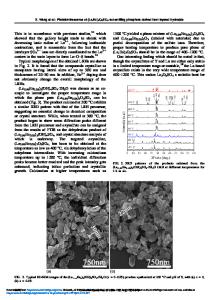Nanostructured red-emitting MgGa 2 O 4 :Eu 3+ phosphors
- PDF / 215,503 Bytes
- 5 Pages / 612 x 792 pts (letter) Page_size
- 93 Downloads / 357 Views
Nano-grained phosphors of Eu3+-doped MgGa2O4 crystallites were prepared by sol-gel technique. The characterization and optical properties of luminescent MgGa2O4:Eu3+ powders have been investigated. The dried sol-gel powders were calcined in air at different temperature from 600 to 1000 °C for 5 h. The x-ray diffraction profiles showed that the MgGa2O4:Eu3+ powders began to crystallize around 600 °C and formed stable MgGa2O4 phase in the temperature range of 600–900 °C. The transmission electron microscopy morphology observations revealed that the fired powders exhibit small grain size less than 20 nm. In the PL studies, under ultraviolet (394 nm) excitation, the calcined powders emitted bright red luminescence (615 nm, 5D0→7F2), and the powders fired at 900 °C were found to have the maximum photoluminescence intensity. The quenching concentration of Eu3+ in MgGa2O4 crystallites was also indicated to be about 5∼6 mol%.
I. INTRODUCTION
In recent years, there has been a great deal of interest on flat panel displays including plasma display panels, field-emission displays, and electroluminescence displays. Among display panels, luminescent phosphors were the key materials and became a very popular research topic. In the past, the sulfide-based materials that were widely used in the traditional cathode-ray tube displays as phosphors could not be used here anymore due to the degradation and outgassing under low-voltage electron bombardment in a vacuum operating environment.1–4 The oxide-based phosphors with excellent thermal and chemical stability have received increasing attention.5–8 Many efforts have focused on improving the performance of oxide-based luminescent materials. The emission efficiency and intensity of phosphors could be improved by both a new host material and synthetic techniques. The luminescence behaviors of the Eu3+ activator have extensively been studied by many researchers.9,10 However, to our knowledge, only the transition metalion–doped magnesium gallate spinels were investigated.11,12 To date, rare earth–doped magnesium gallate spinels were not reported. In this paper, MgGa2O4 was selected as host and Eu as activator. The MgGa2O4 crystal has a spinel structure with a partially inverted nature,
a)
Address all correspondence to this author. e-mail: [email protected] DOI: 10.1557/JMR.2004.0201 1504
http://journals.cambridge.org
J. Mater. Res., Vol. 19, No. 5, May 2004 Downloaded: 19 Apr 2015
having a unit cell belonging to the cubic space group Fd3m. In this compound, the population of Mg2+ ions in tetrahedral and octahedral sites are 0.16 and 0.84, respectively.13,14 In effect, the luminescent properties of phosphors are strongly dependent on the crystal structure and grain size of the host materials. It has been reported that fine grain size could enhance the emission efficiency and intensity of phosphors.9,15–17 On the demand of manufacturing fine grain size, many chemical methods were investigated, such as sol-gel,18–20 hydrothermal,21–23 and precipitate24 methods. Sol-gel process i
Data Loading...











